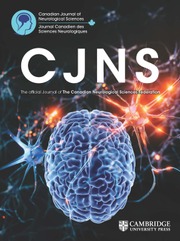No CrossRef data available.
Article contents
Improving Epilepsy Care in Ontario, Canada: The Impact of a Provincial Strategy for Epilepsy Care
Published online by Cambridge University Press: 31 January 2025
Abstract
In 2016, the Ontario Ministry of Health and Long-Term Care implemented the Provincial Strategy for Epilepsy Care to increase epilepsy surgery use in Ontario, Canada. The objectives of this study were to assess whether the use of (1) epilepsy surgery, including (a) its receipt and (b) assessments for candidacy, and (2) other healthcare for epilepsy, including (a) neurological consultations, (b) emergency department (ED) visits and (c) hospital admissions, changed since its implementation.
We used linked health administrative data and an interrupted time series design. Annual cohorts were created for July 1st to June 30th of each year from 2007 to 2019, comprising patients with drug-resistant epilepsy eligible for publicly funded prescription drug coverage with no cancer history. We used segmented Poisson regression models to assess whether the annual rates of each outcome changed between the period before the Provincial Strategy was implemented (July 2007–June 2016) and the period after.
There was a level increase in the rate of epilepsy surgery of 48% (95% CI: 0%, 118%) and slope decreases in the rates of neurological consultations, ED visits and hospital admissions for epilepsy of 10% (95% CI: −15%, −5%), 10% (95% CI: −20%, 1%) and 7% (95% CI: −12%, −1%) per year, respectively, associated with the Provincial Strategy.
The Provincial Strategy may be associated with an increased rate of epilepsy surgery and reduced rates of other healthcare use for epilepsy. Other regions experiencing low epilepsy surgery rates may benefit from similar interventions.
Résumé
Améliorer les soins de l’épilepsie en Ontario (Canada) : l’incidence d’une stratégie provinciale de traitement de l’épilepsie.
En 2016, le ministère de la Santé et des Soins de longue durée de l’Ontario a mis en œuvre une stratégie provinciale de traitement de l’épilepsie pour accroître le recours au traitement chirurgical de cette maladie en Ontario (Canada). La présente étude visait à évaluer si : 1) le recours au traitement chirurgical de l’épilepsie, qui comprenait : a) la réception des demandes et b) l’évaluation de l’admissibilité des cas; et 2) celui à d’autres soins contre l’épilepsie, qui comprenait a) les consultations en neurologie; b) les visites aux services des urgences; et c) les hospitalisations, avaient évolué depuis la mise en œuvre du plan d’actions.
Nous avons utilisé des données administratives liées sur la santé et un devis à séries temporelles interrompues. Des cohortes annuelles ont été créées du 1er juillet au 30 juin de chaque année, de 2007 à 2019, comprenant des patients atteints d’épilepsie pharmacorésistante, admissibles à un régime public d’assurance-médicaments et exempts d’antécédents de cancer. Nous avons utilisé des modèles de régression de Poisson segmentée pour déterminer si les taux annuels de chaque critère d’évaluation avaient varié entre la période qui précédait la mise en œuvre de la stratégie provinciale (de juillet 2007 à juin 2016) et celle qui la suivait.
Nous avons constaté une augmentation de 48 % (intervalle de confiance [IC] à 95 % : de 0 % à 118 %) du recours au traitement chirurgical de l’épilepsie, et une diminution des taux de consultation en neurologie, de visite aux services des urgences et d’hospitalisation pour cause d’épilepsie, de 10 % (IC à 95 % : de -15 % à -5 %), de 10 % (IC à 95 % : de -20 % à 1 %) et de 7 % (IC à 95 % : de -12 % à -1 %) par année, respectivement, associée à la mise en œuvre de la stratégie provinciale.
La stratégie provinciale serait associée à un recours accru au traitement chirurgical de l’épilepsie et à une diminution du recours aux autres types de soins contre l’épilepsie. Peut-être que les régions dans lesquelles il y a un faible recours au traitement chirurgical de l’épilepsie pourraient tirer profit d’interventions similaires.
- Type
- Original Article
- Information
- Copyright
- © The Author(s), 2025. Published by Cambridge University Press on behalf of Canadian Neurological Sciences Federation


